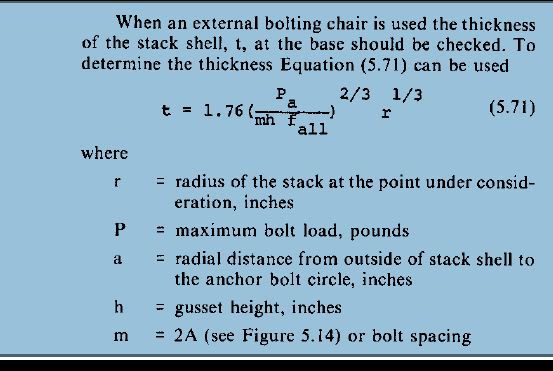EmilianoS87
Mechanical
Hi, on API 650 paragraph 5.12.7 refers to AISI reference as an acceptable procedure for anchor chair design. When I check the reference in order to calculate shell stress an anchors there is a difference in the Z reduction factor with other references like Denis Moss Pressure Vessel Handbook (3rd and 4th edition). In one reference it uses .177 factor and in the other 1.77 factor on the same formula. Anyone have any insights in these particular topic?
Thanks in advance.
"5.12.7 Attachment of the anchor bolts to the shell shall be through stiffened chair-type assemblies or anchor rings of sufficient size and height. An acceptable procedure for anchor chair design is given in AISI Steel Plate Engineering Data, Volume 2, Part 5, “Anchor Bolt Chairs.” See Figure 5.28 for typical chair detail. When acceptable to the Purchaser, hold down straps may be used. See 5.12.15 for strap design requirements and Figure 5.29 and Figure 5.30 for typical hold down strap configurations."
Thanks in advance.
"5.12.7 Attachment of the anchor bolts to the shell shall be through stiffened chair-type assemblies or anchor rings of sufficient size and height. An acceptable procedure for anchor chair design is given in AISI Steel Plate Engineering Data, Volume 2, Part 5, “Anchor Bolt Chairs.” See Figure 5.28 for typical chair detail. When acceptable to the Purchaser, hold down straps may be used. See 5.12.15 for strap design requirements and Figure 5.29 and Figure 5.30 for typical hold down strap configurations."

